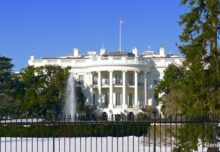Renee Sklarew, coauthor of The Unofficial Guide to Washington, D.C., shares with us important tips for international visitors. Our nation’s capital is a popular destination for visitors from around the world, and one way to prepare for a visit is to read The Unofficial Guide to Washington, D.C. The book features insider advice for all visitors, but as policies change frequently, this information is especially useful to those traveling from out of the country.
1. Who needs a visa? Visitors from 38 countries, including many in Western Europe, the United Kingdom, Japan, and New Zealand, who stay in the U.S. for fewer than 90 days, need only a valid, machine-readable passport, not a visa, plus a round-trip or return ticket. These international visitors are part of the VWP (Visa Waiver Program). Canadian citizens need a passport if arriving by air, but most do not need a visa to enter the United States. For more information, visit US Travel.gov
2. How do I get a visa? Check with The Visa Waiver Program (VWP) to see if you are eligible to travel to the United States for tourism or business for stays of 90 days or less without first obtaining a visa. The U.S. Customs and Border Protection recommends any traveler to the U.S. check his or her ESTA status before making travel reservations or traveling here. More information is available on the DHS website. Many travelers must have a valid Electronic System for Travel Authorization (ESTA) approval prior to travel. If you wish to have a visa in your passport, you may apply for a visitor (B) visa. Most business and tourism travelers use B-1 and B-2 visitor visas. B-1 visa classification is for business travelers to consult with business associates, attend a conference, settle an estate, or negotiate a contract. B-2 visa classification is for tourists on vacation and people coming for medical treatment, a social event, or participation in amateur contests.
3. What type of passport do international visitors to Washington, D.C., need? Citizens of countries other than Canada and Bermuda must have a passport good for at least six months beyond the projected end of the visit. In many cases, they also need a tourist visa from any U.S. consulate. The U.S. currently accepts the European Union’s new EULP travel document as a “passport” for visa issuance and travel to the United States. The Visa Waiver Passport must have a machine-readable zone on the biographic page. The passport must be an electronic passport with a digital chip containing biometric information about the passport owner. An option for frequent travelers to consider is Global Entry.
4. Do international visitors need any vaccinations? There are no vaccination recommendations for visitors to the U.S. at this time, but all visitors should check with their local consulate to see whether travelers from your country are currently required to have any inoculations. If there has been any sort of epidemic in your homeland, there may be restrictions.
5. What if I get sick while visiting? International visitors should also remember that the United States does not have a national medical program, and that if you require medical treatment, you will have to pay for it, so consider buying medical and/or travel insurance. The U.S. does have emergency medical or police service free by dialing 911, and an ambulance or police cruiser will be dispatched to help you. You can also contact the Traveler’s Aid Society International in the Washington area at 202-546-1127 (travelersaid.org).
6. What should I know about Customs? If you arrive by air, be prepared to spend as much as two hours entering the country and getting through U.S. Customs. No food or plants may be brought in, and the contents of personal laptops and other electronic devices will be examined.
7. How much money will I need to visit Washington, D.C.? Although many museums and activities in Washington, D.C., are free, you’ll need money or a credit card for food, tours, transportation, and some attractions. Money is in currency bills that come in $1, $5, $10, $20, $50, $100, and $500, but don’t carry bills in excess of $50 or $100. Stick to $20s for taxicabs, if you do not want to use a credit card; drivers rarely can make change for anything larger. Uber and Lyft are alternatives to cab service. The Metro Subway, tours, and bus service are excellent options for getting around the city.
8. Can I drink alcohol? Remember that the legal drinking age in the United States is 21, and most Washington restaurants and all cultural facilities are nonsmoking.
9. Which airport is the best one? Washington, D.C., has service from three airports. Reagan National is the closest airport to downtown Washington (about 20 minutes away) and has a dedicated Metro station. Dulles International Airport is about 45–60 minutes outside of town (no Metrorail service until 2019, but there are buses). Baltimore/Washington International Thurgood Marshall Airport, known as BWI, is closer to Baltimore than to D.C. but is accessible by MARC commuter trains and Amtrak. Taking the train to BWI often saves money over cabs and cars.
10. How do you get around Washington, D.C.? Should I rent a car? Unless you plan to visit some nearby attractions like Mount Vernon or stay overnight in Annapolis, you won’t need a rental car. The best way to get around is by taking the Metro. Because many major attractions are Metro-accessible, consider choosing a hotel within walking distance of Metrorail stations, like Penn Quarter/Chinatown, McPherson Square, or Metro Center. These stations are close to dozens of major attractions and restaurants. Another option is to stay across the Potomac River from Washington, D.C., in Arlington, Virginia. Check out hotels near Metro stations like Rosslyn, Pentagon City, Crystal City, and Reagan National Airport.
Hotels are typically less expensive in Virginia, and some hotel deals can be found just across the Potomac River in Arlington, Virginia. Be sure to read our discussion about Washington’s neighborhoods, “Where to Go,” in The Unofficial Guide to Washington, D.C. to help you choose a home base for your visit. Lots of transportation options are available for visitors touring D.C.
Last but not least: Rules change quickly, so be sure to check with your local authorities to be sure you’ve made the proper arrangements. We look forward to greeting you!
If you enjoyed this post, sign up for our newsletter here.










